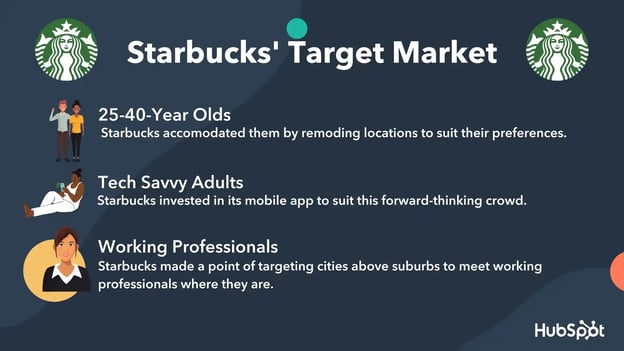Sales teams and entrepreneurs need to know their target market. You can get there by asking yourself, "Who is the ideal fit for my offering? What are their interests and priorities?"

Answering these questions can help you prioritize the deals you're most likely to win. But how can you really understand the ins-and-outs of your target market?
Let's take a closer look at what a target market is, go over how to conduct a target market analysis, see some helpful examples, review target market segmentation, and look into how sales teams can leverage target markets.
Table of Contents
How to Analyze Your Target Market
Target Market Analysis Example
How Sales Teams Can Leverage Target Markets
What Is a Target Market?
A target market is a group of customers for which your products and services are aimed. First defined by an industry (i.e., healthcare, travel, technology, etc.), it represents a specific subset of the broader market the industry covers. It's usually based on factors like behavioral tendencies, geographic location, and demographic characteristics.
Let's say you've created a B2B software product that helps remote construction teams. In that case (and to state the obvious), you'd probably focus on companies within the construction industry. But defining your target market doesn't stop there.
You know your industry, but there's no one-size-fits-all mold for the businesses within it. If you were pinning down a target market for your product, you'd have to start with business characteristics — for instance, scale would be a good place to begin.
Your product will suit certain companies better than others, and selling to a Fortune 1000 company isn't the same as a small construction business with less than 100 employees.
In this case, you'd want to pin down the size of your ideal customer's business — and this number would be the start of a target market analysis.
Let's take a closer look at what that process looks like.
How to Analyze Your Target Market
- Analyze your product or service.
- Check out the competition.
- Choose criteria to segment by.
- Perform research.
- Track and evaluate your results.
As the name implies, target market analysis is the basis for identifying your target market. Here are the five steps you can take to do one of your own.
1. Analyze your product or service.
Take a look at what you're selling to understand which consumers would get value from your product. The questions below will help with the brainstorming process:
- "What need does your product or service fill?"
- "Are there any problems or pain points it solves for?"
- "Who would benefit most from your product or service?"
Once you've answered these questions, you might want to consider getting feedback from current customers. Conduct a focus group or ask your service department about their common problems.
Analyzing your product or service in this way will help you better understand your target market. In fact, you might learn that your current customers aren't the people you're trying to target. If you notice a disconnect in this process, you'll want to better align your target market with your actual marketing goals so you can realign.
2. Check out the competition.
Perform an analysis of your competitors to see who they're targeting. Take a look at their customer base, and see if you can find an area of the market you could focus on that they might be missing.
The best way to do this is to conduct a competitive analysis. This entails researching who your competitors are, what they offer, and even review their sales tactics.
Looking at your competitors will even help you identify target market gaps that you can fill. Are there any target markets they do not focusing on?
This could lead you to expand into new markets geographically or develop new products to target a different market.
3. Choose criteria to segment by.
A target market can be segmented by a few different variables. Consumers can be split by demographic, geographic, and behavioral factors.
This is essentially the process of creating a buyer persona. You'll divide your target market into several target customers — also known as (you guessed it) buyer personas.
For example, perhaps your target market is midsized companies looking to purchase marketing automation software. You could divide your target customers into several groups, including marketing department leaders, sales leaders, founders, or CEOs.
Here are some of the most common ways to segment a target market:
- Age
- Gender
- Income
- Location
- Behavior
- Lifestyle
- Values
- Interests
4. Perform research.
As you begin narrowing your market, the research phase doesn't end there. What marketing strategies should you use to reach your potential target market? Is the target market large enough for your product or service? Market research will help you learn more about your target market.
Picking the right target market can tell you a great deal about your business. Are you looking to become a true velocity business, or do you see yourself as a steadier flow of pipeline with enterprises and consumers?
5. Track and evaluate your results.
Target market analysis should never be static — you don't just conduct one, be immediately content with the results, and stop there. It's an ongoing process. You need to continuously track your results, evaluate what you see, and iterate on the conception of your target market to more effectively appeal to it.
Target Market Analysis Example
Let's imagine a company that sells inexpensive, "function-over-form" athletic footwear that stresses comfort and arch support instead of trendy aesthetics.
1. Analyze the product or service.
When conducting its target market analysis, the business in question would have to start by taking a thorough, objective look at its product to get a solid grip on its value and differentiating factors.
The company would likely find that its shoes are better suited for day-to-day wear instead of legitimate athletic competition, lack trendy appeal, and can help with sore feet while standing.
This initial insight can help shape the personas that the company will ultimately target. It would have a better picture of how to construct its value proposition. In this case, the business might find that suburban men over 50 who don't exercise regularly appear to be the most likely to buy its shoes.
2. Check out the competition.
Next, the company would dig into its competitor's products, how they were selling them, and any noticeable gaps in their potential target markets. After conducting a competitive analysis, the company might find that its competition was ignoring some geographical trends embedded in its target markets.
Let's say its competitors' retail locations and store placements were primarily in cities — ignoring locations like suburban strip malls and local "mom and pop" retail stores. With that information in mind, the company in question could have a starting point for appealing to a target market its competition is ignoring.
3. Choose criteria to segment by.
Here, the company would begin to string more detailed personas together. Again, it would base its segmentation criteria on its product analysis and refine it according to its competitive analysis.
In this case, a significant portion of the criteria would revolve around age, social class, location, and interests — making one of its personas older, working class, suburban consumers who prioritize function over form.
4. Perform research.
After creating its target persona, the company would conduct a market analysis, survey consumers that fit its target market bill, potentially employ more direct tactics like hosting focus groups, and take any other strides it sees fit to ensure that it has a thorough understanding of its target consumers.
From there, it can shape a thoughtful value proposition that will guide its sales messaging, outreach strategies, pricing structure, and other crucial sales-related factors that influence how it reaches consumers.
5. Track and evaluate results.
Once the other steps have been covered, the company would continue to monitor how its efforts resonate with its target persona. If sales aren't where they need to be — or it appears the company might have other personas it can cater to — it might restart this process and shift gears on its messaging, strategies, or target market as a whole.
Let's look at some of the best-in-class companies — both B2C and B2B — to see how they set up their target markets.
Target Market Examples
1. Atlassian Target Market
Atlassian offers a suite of collaboration tools designed to help developers and product leaders take their projects from concept to completion.
Like most larger companies, Atlassian uses target market segmentation to look at different markets and break up its unique value propositions, terminology, and values.
By diving into one segment, like retail, we see they're working with several large companies — especially with their support-related products.
This tells us that while Atlassian can work with almost anyone doing software development, it recognizes how its value proposition changes depending on the market segment in question.
Even the same product for two different customer types creates different levels of value.
2. Nike Target Market
Nike offers products to athletes and other consumers who want to exercise regularly. They offer apparel, equipment, shoes, and accessories.
They work with athletes and a fitness-minded audience, but we know a good target market definition can't be that broad. Let's break two of their segments down:
- Young athletes — Kids who get frequent exercise and play sports growing up are a huge, growing category for Nike. Nike engages with this market through sports leagues and associations and with endorsements from popular sports stars like LeBron James.
- Runners — With a focus on new types of shoes, Nike shows it targets consumers based on both demographic information and lifestyle. Nike launches shoes and apparel designed to help the avid runner stay on the road a bit longer.
3. Starbucks Target Market
Next time you're sipping your cold foam Cascara cold brew, ponder the target market of the top coffee destination in town: Starbucks.
Many of their locations have been remodeled and offer a hip, contemporary look. Not that surprising since about half of their customers are between the ages of 25 and 40.
If you spend more than five minutes sitting and drinking your coffee, you'll probably hear a barista shout, "mobile order!" The mobile process now accounts for 24% of Starbucks' transactions which shows they're catering to a tech-savvy crowd.
The next clue we have on their target market is the location of their shops. By positioning its locations in heavily urban areas, Starbucks is attracting on-the-go professionals. To recap, here are a few of Starbucks' target markets:
- 25 - 40-year-olds — Remodeled locations accommodate their largest demographic base.
- Tech-savvy adults — Their mobile app has caught on and lends itself to a forward-thinking crowd.
- Working professionals — Their urban focus tells us the type of lifestyle they're catering to.

4. Apple Target Market
What about a company that occupies both the B2B and B2C spaces? How can it develop a target market with such a broad set of customers? Apple is the textbook case for innovation and product design.
But how does that apply to finding a target market? With its wide array of product offerings, Apple has a little something for everyone. Here are two of their target markets:
- Tech enthusiasts — A customer category that launched Apple's brand decades ago, technology enthusiasts still get attention from the company. With launches of new tech categories (including wearables, Apple TVs, and HomePods), Apple has shown it's still creating value for this segment. There is also a tremendous ecosystem where owning a suite of Apple products enables better interoperability among your tech.
- Healthcare — One market Apple has its eyes on is healthcare. By focusing on the appeal of having information right at your fingertips with mobile and the iPad, they've positioned healthcare workers to more conveniently communicate with patients.
Apple doesn't seem to exclude many people from its target market and has positioned itself to benefit both consumers and businesses — even with the same products like the iPad.
Its success has been more about understanding the value of its different segments rather than excluding people from them.
5. McDonald's Target Market
McDonald's target market is broad and encompasses a wide variety of customer personas. Younger professionals represent one of the chain's more prominent target market segments — and that trend is reflected in many of the company's location remodels. Several McDonald's franchises have been revamped to look sleeker, more modern, and better suited for millennials.

Image Source: Community Impact
"Full nest" families with children over six represent another key base for the chain. The franchise takes many strides to appeal to this specific segment, primarily reflected in its Happy Meal options.
But there's another factor that underscores virtually every target market McDonald's tries to appeal to — social class. The chain makes a conscious effort to resonate with lower, working, and middle-class patrons.
Pricing is the basis of McDonald's value proposition. It tries to bill itself as an affordable alternative to more expensive options in the spaces it attempts to sell in. For instance, when promoting its McCafe line, the chain stressed the brand's particularly low price points as a major selling point.

Ultimately, the franchise's target market isn't singular and clear-cut in terms of most demographics — but it is specific in terms of its various personas' economic circumstances. Its value proposition fundamentally rests on the fact that its food is inexpensive.
Target Customers
A target customer is an individual that's most likely to buy your product. And it's a subset of the broader target market. For example, if your target market is female athletes between the ages of 13 to 25, a target customer could be female athletes in the specific age range of 13 to 16.
You need to have a firm grasp of your target customers if you're going to develop pointed, effective value propositions. The success and viability of your sales messaging, prospecting efforts, and broader sales process rests on your knowledge of who's buying your product or service and the mindset that makes them do it.
That starts with target market segmentation.
Target Market Segmentation
Target market segmentation is the process of partitioning your target audience into more focused, identifiable, and approachable groups (or segments). It's a broad concept that can take on a lot of forms, including:
- Geographic segmentation — Dividing your target market based on geographical boundaries
- Firmographic segmentation — A practice specific to B2B sales where firms are divided based on characteristics like company size or number of employees
- Behavioral segmentation — Dividing your target market based on behavioral tendencies and decision-making patterns
- Demographic segmentation — Dividing your target market based on factors like income, education, race, gender, or occupation
- Psychographic segmentation — Dividing your target market-based elements like personality traits, values, and opinions
How you elect to segment your target market will be specific to your company's needs and interests. In many — if not most — cases, you'll employ more than one of the segmentation methods listed above when defining a target market.
When you identify the customers you want to serve — and the ones you don't — ask:
- "Do my target customers have different problems they're solving with my product?"
- "Do my target customers get different value from my product?"
- "Are either of these things related to demographic, geographic, or lifestyle components?"
In order to segment effectively, you must have a decent way of measuring the value you provide to the market. Then, identify if certain groups are getting more value than others.
This will power the positioning of your product. Suddenly, you can pinpoint pain for your customers while speaking their language.
This helps you refine your position in the market and connect on a deeper level with your customer. Having a target market (or target customer) is all about relevancy and relating to the person on the other side of the cash register.
How Sales Teams Can Leverage Target Markets + Segmentation
Segmentation poses several benefits for sales teams. If you know who will be most receptive to your product or service, you get a leg up when conducting most steps of your sales process.

For one, effective segmentation can be a major asset in prospecting. If your SDRs have a solid picture of the types of customers that show an interest in your offering, cold leads can become a little warmer — letting those reps make more thoughtfully guided use of your sales messaging when connecting with prospects.
Beyond that, segmentation can also help with lead qualification. Knowing whether a lead fits the bill of a class of high-converting customers gives reps a head start during that stage.
You need to have some kind of criteria that can immediately distinguish a prospect who needs your product or service from one that lacks the decision-making tendencies, location, or economic circumstances to actually get something out of it. Target market segmentation gets you there.
Finally, target markets provide sales teams with the necessary information to breach new markets and sell to them effectively. If you're not on top of any emerging markets that might need your product or service, you could hit a wall with your sales potential and lose out on incredibly lucrative business opportunities.
Ultimately, knowing your target markets inside and out is one of the most fundamental tenets of successful sales efforts. If you're not actively analyzing, pursuing, and refining your understanding of your target markets, you're losing out on sales and painting yourself into a corner with your business potential.
Editor's note: This post was originally published in July 2018 and has been updated for comprehensiveness.
![→ Download Now: Market Research Templates [Free Kit]](https://no-cache.hubspot.com/cta/default/53/6ba52ce7-bb69-4b63-965b-4ea21ba905da.png)










